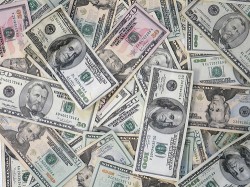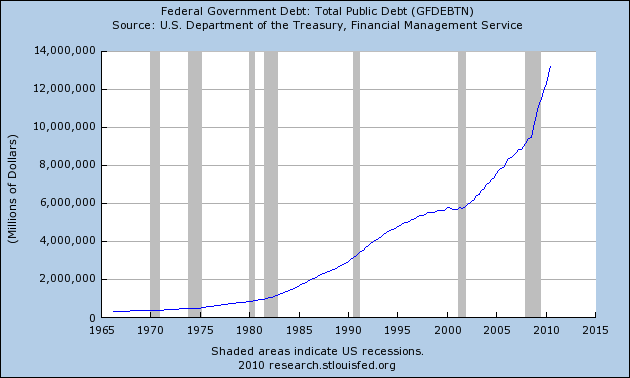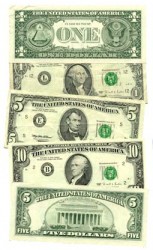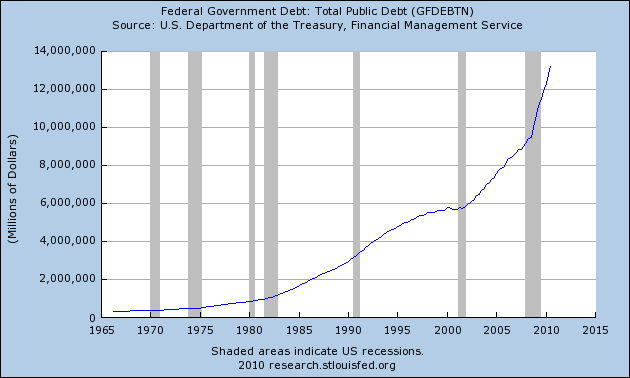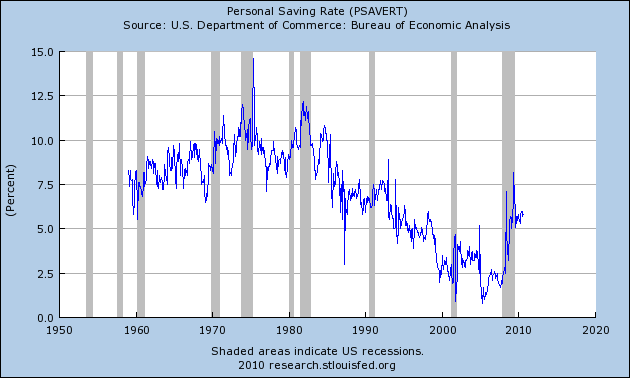 If you haven’t noticed lately, America is literally falling apart all around us. Decaying infrastructure is everywhere. Our roads and bridges are crumbling and are full of holes. Our rail system is ancient. Our airports and runways have definitely seen their better days. Aging sewer systems all over the country are leaking raw sewage all over the place. The power grid is straining to keep up with the ever-increasing thirst of the American people for electricity. Dams are failing at an unprecedented rate. Virtually all of our ports are handling far more traffic than they were ever intended to handle. Meanwhile, our national spending on infrastructure is way down. Back during the 1950s and 1960s we were spending between 3 and 4 percent of our national GDP on infrastructure, but today we are spending less than 2.5 percent of our national GDP on it. According to the American Society of Civil Engineers, we need to spend approximately $2.2 trillion on infrastructure repairs and upgrades just to bring our existing infrastructure up to “good condition”.
If you haven’t noticed lately, America is literally falling apart all around us. Decaying infrastructure is everywhere. Our roads and bridges are crumbling and are full of holes. Our rail system is ancient. Our airports and runways have definitely seen their better days. Aging sewer systems all over the country are leaking raw sewage all over the place. The power grid is straining to keep up with the ever-increasing thirst of the American people for electricity. Dams are failing at an unprecedented rate. Virtually all of our ports are handling far more traffic than they were ever intended to handle. Meanwhile, our national spending on infrastructure is way down. Back during the 1950s and 1960s we were spending between 3 and 4 percent of our national GDP on infrastructure, but today we are spending less than 2.5 percent of our national GDP on it. According to the American Society of Civil Engineers, we need to spend approximately $2.2 trillion on infrastructure repairs and upgrades just to bring our existing infrastructure up to “good condition”.
Does anyone have an extra $2.2 trillion to spare?
If you get the feeling that America is decaying as you drive around this great country of ours, it is not just your imagination. It is literally happening.
You should not read the list of facts below if you want to keep feeling good about the condition of America’s infrastructure. There really is no way to sugar-coat what is happening. Previous generations handed us the greatest national infrastructure that anyone in the world has ever seen and we have neglected it and have allowed it to badly deteriorate.
This first set of facts about America’s decaying infrastructure was compiled from a fact sheet entitled “The Case For U.S. Infrastructure Investment” by an organization called Building America’s Future….
*****
#1 One-third of America’s major roads are in poor or mediocre condition.
#2 Traffic on more than half the miles of interstate highway exceeds 70 percent of capacity, and nearly 25 percent of the miles are strained at more than 95 percent of capacity.
#3 Americans waste 4.2 billion hours and 2.8 billion gallons fuel a year sitting in traffic – equal to nearly one full work week and three weeks’ worth of gas for every traveler.
#4 Over the next 30 years, our nation is expected to grow by 100 million and highway traffic will double again. Even if highway capacity grows no faster than in the last 25 years, Americans can expect to spend 160 hours – 4 work weeks – each year in traffic by 2035.
#5 Nearly a third of all highway fatalities are due to substandard road conditions, obsolete road designs, or roadside hazards.
#6 Over 4,095 dams are “unsafe” and have deficiencies that leave them more susceptible to failure, especially during large flood events or earthquakes.
#7 Rolling blackouts and inefficiencies in the U.S. electrical grid cost an estimated $80 billion a year.
#8 By 2020, every major U.S. container port is projected to at least double the volume of cargo it was designed to handle. Some East Coast ports will triple in volume, and some West Coast ports will quadruple.
#9 Other countries are leapfrogging past us by investing in world-class ports. China is investing $6.9 billion; the port of Shanghai now has almost as much container capacity as all U.S. ports combined.
#10 By 2020, China plans to build 55,000 miles of highways, more than the total length of the U.S. interstate system.
*****
The rest of these facts were compiled from various sources around the Internet. The more research that you do into America’s decaying infrastructure the more depressing it becomes….
#11 According to the U.S. Department of Transportation, more than 25 percent of America’s nearly 600,000 bridges need significant repairs or are burdened with more traffic than they were designed to carry.
#12 More than a third of all dam failures or near failures since 1874 have happened in just the last decade.
#13 All across the United States, conditions at many state parks, recreation areas and historic sites are deplorable at best. Some states have backlogs of repair projects that are now over a billion dollars long. The following is a quote from a recent MSNBC article about these project backlogs….
More than a dozen states estimate that their backlogs are at least $100 million. Massachusetts and New York’s are at least $1 billion. Hawaii officials called park conditions “deplorable” in a December report asking for $50 million per year for five years to tackle a $240 million backlog that covers parks, trails and harbors.
#14 Over the past year, approximately 100 of New York’s state parks and historic sites have had to cut services and reduce hours.
#15 All over America, asphalt roads are being ground up and are being replaced with gravel because it is cheaper to maintain. The state of South Dakota has transformed over 100 miles of asphalt road into gravel over the past year, and 38 out of the 83 counties in the state of Michigan have transformed at least some of their asphalt roads into gravel roads.
So why don’t our state and local governments just spend the money necessary to fix all of these problems?
Well, they can’t spend the money because they are flat broke.
Just consider some of the financial problems that state and local governments around the nation are facing right now….
#16 One town in Michigan is so incredibly broke that it is literally begging the state to allow them to declare bankruptcy.
#17 One Alabama town is in such financial turmoil that it has decided to simply quit paying pension benefits.
#18 In Georgia, the county of Clayton recently eliminated its entire public bus system in order to save 8 million dollars.
#19 Major cities such as Philadelphia, Baltimore and Sacramento are so desperate to save money that they have instituted “rolling brownouts” in which various city fire stations are shut down on a rotating basis throughout the week.
#20 Detroit Mayor Dave Bing has come up with a unique way to save money. He wants to cut 20 percent of Detroit off from essential social services such as road repairs, police patrols, functioning street lights and garbage collection.
The truth is that there are dozens of cities across the United States that are on the brink of bankruptcy. To see a bunch of high profile examples of this, check out the following article from Business Insider: “16 US Cities Facing Bankruptcy If They Don’t Make Deep Cuts In 2011“.
But it just isn’t local governments that are in deep trouble right now. In fact, there are quite a few state governments that are complete and total financial disaster zones at this point.
According to 60 Minutes, the state of Illinois is at least six months behind on their bill payments. 60 Minutes correspondent Steve Croft recently asked Illinois state Comptroller Dan Hynes how many people and organizations are waiting to be paid by the state, and this is how Hynes responded….
“It’s fair to say that there are tens of thousands if not hundreds of thousands of people waiting to be paid by the state.”
Investors across the globe are watching all this and they are starting to panic. In fact, investors are now pulling money out of municipal bonds at a rate that is absolutely staggering.
But if states get cut off from all the debt that they need to operate, things are going to get a lot worse very quickly.
Already we are seeing all kinds of troubling signs. For example, the state of Arizona recently decided to stop paying for many types of organ transplants for people enrolled in its Medicaid program.
Sadly, as much as our politicians try to “fix” our problems, things just only seem to keep getting worse.
One prominent illustration of this is our health care system. Our health care system is absolutely falling apart all around us. Thanks to the new health care reform law, doctors are flocking out of the profession in droves. According to an absolutely stunning new poll, 40 percent of all U.S. doctors plan to bail out of the profession over the next three years.
Our economy continues to fall apart as well. The number of personal bankruptcies in the United States continues to set stunning new highs. According to the American Bankruptcy Institute, more than 1.53 million Americans filed bankruptcy petitions in 2010. This was up 9 percent from 1.41 million in 2009.
Not only that, but the housing crisis shows no signs of abating. 382,000 new foreclosures were initiated during the third quarter of 2010. This was up 31.2 percent from the previous quarter and it was 3.7 percent higher than the third quarter of 2009.
The U.S. banking system is also falling apart. In 2006, no U.S. banks failed. In 2009, 140 U.S. banks failed. So did things get better in 2010? No. In 2010, 157 U.S. banks failed.
Unemployment continues to remain at depressingly high levels, and in many areas of the country it is getting even worse. According to the U.S. Labor Department, the unemployment rate rose in two-thirds of America’s largest metro areas during November.
Millions of Americans have become so disgusted with the job market that they have given up altogether. The number of people who are so discouraged that they have completely given up searching for work now stands at an all-time high.
So who is doing a booming business during these hard times? Welfare agencies and food banks are. During this economic downturn, millions of American families have found themselves going to a food bank for the very first time ever.
It is getting harder and harder for average American families to feed themselves. A recent survey conducted by the Pew Research Center found that 29 percent of Americans say that it is hard to afford food, and 48 of Americans say that it is hard to afford their heating and electric bills.
So is there any hope for the future? Well, our new college graduates are supposed to lead us into the future, but most of them are saddled with overwhelming amounts of student loan debt. Those who graduated during 2009 had an average of $24,000 in student loan debt. This represented a 6 percent increase from the previous year.
Not only that, but these new college grads are not finding jobs. According to the one recent report, the unemployment rate for recent college graduates was 8.7 percent in 2009. This was up from 5.8 percent in 2008, and it was the highest unemployment rate ever recorded for college graduates between the ages of 20 to 24.
As if all of this was not bad enough, now the Baby Boomers are starting to reach retirement age. Beginning January 1st, 2011 every single day more than 10,000 Baby Boomers will reach the age of 65. That is going to keep happening every single day for the next 19 years.
So where in the world are we going to come up with all of the money to give them the retirement benefits that they are due?
The truth is that we are flat broke as a nation and so America’s decaying infrastructure is going to continue to decay. We don’t have the money to repair what we already have, much less add desperately needed new infrastructure.
But perhaps it is only fitting. The decay of our roads and cities will match the deep social, moral and political decay that has already been going on in this country for decades.
So will the American people awaken soon enough to be able to recapture the legacy of greatness that previous generations tried to pass on to us?
Unfortunately, the vast majority of our politicians are completely incompetent. Posted below is a short video from Tim Hawkins that is absolutely hilarious but that also demonstrates just how incompetent our government really is….

